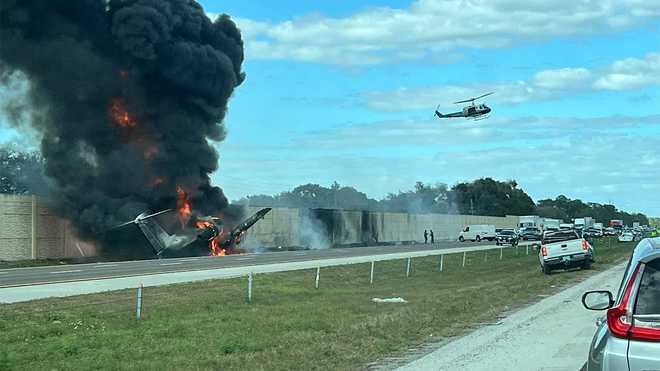A horrific plane crash on I-75 near Naples, Florida, has claimed the lives of two skilled pilots and left three passengers critically injured. The NTSB report, amidst the tragedy, reveals the heroic actions of co-pilot Ian Hofmann, whose bravery shone in his final moments. The report, piecing together the events leading up to the disaster, provides a deeper understanding of the desperate fight to control the doomed aircraft and the incredible courage of those on board.
Engine Failure Turns Routine Flight into Tragedy
It was an ordinary day on that stretch of I-75 until February 9, 2024, when a Bombardier Challenger 600 jet, previously soaring through the sky, hurtled towards the ground. The cause? A terrifying dual engine failure that left the plane powerless, leaving those on board facing unimaginable danger. The crash, a tragedy that claimed the lives of the two pilots, sent shockwaves through the community, leaving many injured and countless others grappling with the aftermath.
Pilots’ Courage Prevents Greater Catastrophe
Amidst the wreckage and grief, a story of incredible courage emerged. The NTSB report, reconstructing the final moments of the flight, revealed that the pilots, faced with their own mortality, acted with incredible selflessness. Knowing they were going down, they made a series of crucial maneuvers, guiding the crippled plane away from the packed lanes of the busy interstate. Their bravery, a testament to their training and character, undoubtedly saved lives that day, preventing an even greater catastrophe.
The families of the pilots, though heartbroken, expressed a profound sense of pride. Their fathers, they said, were heroes who stayed calm in the face of danger, putting the lives of others before their own.
NTSB Investigation: The Search for Answers
The question of “why?” hung heavy in the air. Why did a modern jet, seemingly in good condition, suddenly lose both its engines? The NTSB investigation, a meticulous search for answers, began immediately. Their preliminary findings confirmed the initial reports: dual engine failure was the cause of the crash.
Investigators revealed that the pilots, recognizing the gravity of the situation, desperately contacted air traffic control, their voices filled with urgency as they reported the failing engines. The plane, no longer able to maintain altitude, began its tragic descent onto the interstate below.
The investigation, however, is far from over. The wreckage of the aircraft will undergo rigorous analysis, with experts meticulously examining every piece, every system, searching for clues. What caused the engines to fail? Was it a mechanical issue, a latent defect, or something else entirely? These are questions the NTSB is determined to answer. While a preliminary report is expected within 30 days, the full investigation will likely take months, perhaps even years to complete.
Community Support and Lingering Questions
The impact of the crash extended far beyond the immediate crash site. The southbound lanes of I-75, a vital artery for commerce and travel, were closed for hours, causing significant traffic delays that rippled across the region. Businesses were disrupted, commuters stranded, and the rhythm of daily life thrown into disarray.
Yet, even in the face of tragedy, the human spirit shone through. The community, deeply affected by the crash, rallied around those impacted. Support poured in – food, water, and essential supplies for the first responders working tirelessly at the crash site. Local organizations and volunteers offered comfort and aid to the victims and their families, providing counseling, temporary housing, and financial assistance.
The I-75 plane crash, while a singular event, raises broader questions about aviation safety, the fragility of life, and the resilience of the human spirit. Some key areas continue to intrigue investigators and the public alike:
- The Human Factor: The pilots’ heroic actions, their calm in the storm, serve as a stark reminder of the human element present even in the most advanced aircraft. Interviews with family members, friends, and colleagues, paint a picture of these men – their dedication to their profession, their love for flying, and their unwavering courage.
- Safety in the Skies: This crash, with its terrifying dual engine failure, inevitably prompts questions about the safety of small jets. Aviation experts and engineers will be closely examining the NTSB’s findings, looking for lessons learned, potential design flaws, or maintenance practices that need review. This tragedy might well lead to new safety recommendations, stricter regulations, or even design changes in the aviation industry, all aimed at preventing a similar event from happening again.
- The I-75 Artery: The crash and the subsequent closure of a major highway like I-75 highlight the vulnerability of our transportation systems and the far-reaching consequences of such disruptions. This event may prompt transportation officials to review emergency response protocols, explore alternative traffic routing options, and consider infrastructure improvements to minimize disruption in the event of future incidents.
- The Scars That Remain: While physical injuries often heal, the psychological impact of surviving a plane crash or witnessing such a traumatic event can be profound and long-lasting. Mental health professionals emphasize the importance of providing adequate support and resources for survivors, first responders, and even those who witnessed the crash from afar. This event underscores the need for greater awareness and understanding of trauma and its lingering effects.
The I-75 plane crash serves as a stark reminder of life’s unpredictability. It compels us to confront our own mortality while simultaneously celebrating the indomitable spirit of those who face adversity with courage and selflessness. As the investigation continues, we can hope for answers, for clarity, and for a renewed commitment to safety in all its forms.
What Caused the Sudden Engine Failure on I-75?
The NTSB, the agency responsible for investigating plane crashes, has been diligently working to determine the cause of the horrific accident on I-75. The incident, where the plane seemingly fell out of the sky, has left many searching for answers. It has been revealed that the pilots exhibited incredible bravery in those final moments.
Imagine: you’re flying along, and suddenly, both engines fail. That’s precisely the harrowing situation these pilots faced. But instead of succumbing to panic, they focused on steering the plane away from neighborhoods, schools, and anywhere that could have resulted in a far greater disaster. They prioritized everyone else’s lives over their own, embodying the true definition of heroism.
The critical question everyone is asking is: what caused both engines to fail simultaneously? That’s the mystery the NTSB is tirelessly trying to unravel. They’re meticulously examining the plane’s maintenance records for any overlooked warning signs and scrutinizing how those engines are designed. It’s possible that this tragic event could lead to changes in regulations or even how these types of planes are built in the future.
Those who were on I-75 that day, the ones who witnessed the crash, will likely carry that traumatic memory with them for a long time. It’s a stark reminder that life can change in an instant. Some individuals might be struggling to cope with what they saw, and it’s important to remember that they might need extra support to navigate through the emotional aftermath.
It’s essential to understand that these investigations take time. It could be months before we have definitive answers. The NTSB is committed to being absolutely certain about what happened to prevent a similar tragedy from ever happening again.
Who Are the Survivors of the I-75 Plane Crash?
Amidst the wreckage and heartbreak of the devastating plane crash on I-75, three individuals emerged with a story of survival that seems nothing short of miraculous. Their names weren’t just listed in a report; these were real people who stared death in the face and, against all odds, made it out alive.
The first survivor is Sydney Ann Bosmans, a 23-year-old from Jupiter, Florida. Sydney wasn’t just a passenger on this flight; she was a crew member. Imagine the immense pressure and chaos of those final moments, yet in those terrifying seconds after impact, she somehow managed to stay calm and collected enough to not only save herself but to help others as well. Her quick thinking and courage in those initial moments after the crash likely made all the difference.
Then there’s Audra Green, a 23-year-old passenger from Columbus, Ohio. We can only imagine what was going through Audra’s mind as the plane descended, but what we do know is that she fought to survive. Even amidst the fire and wreckage, she clung to hope and found the strength to escape the burning plane. Her determination speaks volumes about the resilience of the human spirit.
Finally, we have Aaron Baker, another passenger from Columbus, Ohio, and 35 years old at the time of the crash. It would be easy to succumb to panic in such a terrifying situation, but it seems Aaron remained clear-headed. He not only survived the crash itself but also played a part in guiding his fellow survivors toward safety, demonstrating remarkable courage and presence of mind in the face of unimaginable terror.
These three survivors, Sydney, Audra, and Aaron, each faced unimaginable horror on that fateful day. Their stories serve as a powerful reminder that even in the darkest of times, hope can endure, and the human spirit can find a way to overcome even the most daunting challenges. While we can only speculate about many of the details of their experience, one thing remains undeniably clear: their survival was not merely an accident but rather a testament to their own strength, courage, and perhaps a bit of luck in the face of unimaginable tragedy.
Unraveling the Cause of the Naples Plane Crash
Following the horrific plane crash on I-75 in Naples, Florida, we are beginning to gain a clearer understanding of the events that might have transpired. The National Transportation Safety Board (NTSB) has been diligently investigating the incident, and their initial findings suggest that the plane’s engine failed, leading to the crash.
Eyewitnesses who observed the plane just before the crash reported that it appeared to be flying unusually low, which aligns with the possibility of an engine failure. The NTSB report revealed a chilling detail: the pilots had radioed in about encountering problems with both engines shortly before the crash.
To help piece together what happened that day, let’s break down the information available:
Timeline of Events:
- February 10th, 2024: The plane takes off from Ohio State University Airport, heading for Naples, Florida.
- Around 3:10 PM: The situation takes a turn for the worse as the plane’s engine fails. The pilots, in a desperate attempt to save the plane and everyone on board, try to make an emergency landing on I-75, near mile marker 107.
- Tragically, the plane crashes, colliding with vehicles on the highway. The two pilots lose their lives, and three passengers are injured.
Key Findings So Far:
- All evidence points to the plane crash being caused by a catastrophic engine failure.
- The pilots were aware of the issue and had reported trouble with both engines before the crash.
- Thankfully, while there were injuries, no one else besides the pilots lost their lives as a result of the crash.
- The NTSB is currently conducting a thorough investigation to determine the root cause of the engine failure.
- This tragic accident serves as a stark reminder of the critical importance of aviation safety and the significance of these investigations in preventing similar incidents from occurring again.
It is crucial to remember that these are only initial findings, and the investigation is still ongoing. Experts will meticulously examine every possible angle, from the plane’s maintenance records to weather conditions that day, to gain a comprehensive understanding of what caused this tragedy.
A Glimmer of Hope: Identifying the Survivors
The terrible plane crash in Naples tragically took the lives of two skilled pilots. Yet, amidst the wreckage and loss, a glimmer of hope emerged: three individuals miraculously survived.
One of the survivors is Sydney Ann Bosmans, a crew member from Jupiter, Florida. Joining her in defying the odds were Aaron Baker and Audra Green, both from Columbus, Ohio. These two were passengers on the flight, and thankfully, they also walked away from the inferno.
It is nothing short of extraordinary that anyone could survive such a horrific event. Their survival provides investigators with a valuable opportunity to understand what went wrong. The National Transportation Safety Board (NTSB) is diligently piecing together the events that led to the plane’s engines failing, examining everything from the plane’s maintenance records to the accounts from the survivors.
Their findings will not only shed light on what happened in this particular crash but could also prevent similar tragedies from occurring in the future. Every detail, every piece of evidence, could be crucial in ensuring that such an event never happens again.
While we mourn the loss of the pilots, it’s vital to acknowledge the strength and sheer will of those who survived. They are living proof of the human spirit’s ability to endure even the most unimaginable situations. Their stories serve as powerful reminders of the preciousness of life and the paramount importance of aviation safety.
- If you are craving some fast and easy food, you should try the San Ysidro McDonald, I swear you will love it!
- If you need to know more about the Kristallnacht book, then click on the link and we will lead the way for you.
- If you are looking for some hairstyle inspiration, 1800 hairdos is the best website that can help you with that.
- Unveiling Bernhard Caesar Einstein’s Scientific Achievements: A Legacy in Engineering - July 15, 2025
- Uncover who is Jerry McSorley: CEO, Family Man, Business Success Story - July 15, 2025
- Discover Bernhard Caesar Einstein’s Scientific Contributions: Unveiling a Legacy Beyond Einstein - July 15, 2025















